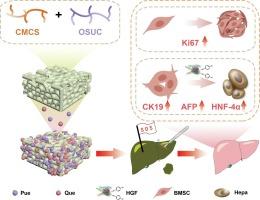双重植物化合物负载壳聚糖水凝胶支架促进细胞增殖,修复肝损伤
IF 6.3
2区 化学
Q1 POLYMER SCIENCE
引用次数: 0
摘要
肝脏组织工程是改善肝脏损伤修复或再生以弥补供体不足的重要方法,其中支架和生物活性因子的结合发挥着至关重要的作用。迄今为止,由于生物相容性方面的障碍,只有极少数产品被用于临床。本文制备了一种基于壳聚糖聚合物的可降解支架系统,该聚合物通过希夫反应交联,具有良好的生物相容性和可降解性。支架中添加了两种具有保护毒性和改善组织形成的天然植物成分,可促进细胞增殖并减少药物用量,进一步降低支架系统的生物毒性,同时确保其持续时间和有效性。此外,我们的支架系统具有与原生组织再生速度相匹配的适当降解率,可在愈合过程中保持机械性能以支持组织形成。实验结果表明,该支架系统具有增强干细胞分化和促进肝脏再生的能力,且降解产物无毒。总之,负载植物成分的无毒可降解支架系统在生物医学领域具有巨大潜力,为构建安全高效的生物医学材料提供了一种新方法。本文章由计算机程序翻译,如有差异,请以英文原文为准。

Dual plant compounds-loaded chitosan hydrogel-based scaffold promotes cell proliferation for repairing liver injury
Liver tissue engineering is an essential approach to improve liver injury repair or regeneration for compensation of donor shortage, in which the combination of scaffolds and bioactive factors play a crucial role. Until now, a minimal number of products are used in clinic for their hurdles of biocompatibility. Here a degradable scaffold system based on chitosan polymers that are cross linked by Schiff reaction was prepared, which exhibits excellent biocompatibility and degradability. Two natural plant components with protective toxicity ability and improved tissue formation were loaded in scaffold to promote the cell proliferation as well as reduced drug dosage, further lowering the bio-toxicity of the scaffold system while ensuring its duration and effectiveness. Furthermore, our scaffold system possesses suitable degradation rate that match the regeneration rate of native tissue, which can maintain mechanical properties to support tissue formation during healing. The experiments results show that the scaffold system has the ability to enhance stem cell differentiation and promote liver regeneration, with non-toxic degradation products. In summary, the non-toxic, degradable scaffold system loaded with plant components holds vast potential in the field of biomedicine, providing a new approach for constructing safe and efficient biomedical materials.
求助全文
通过发布文献求助,成功后即可免费获取论文全文。
去求助
来源期刊

European Polymer Journal
化学-高分子科学
CiteScore
9.90
自引率
10.00%
发文量
691
审稿时长
23 days
期刊介绍:
European Polymer Journal is dedicated to publishing work on fundamental and applied polymer chemistry and macromolecular materials. The journal covers all aspects of polymer synthesis, including polymerization mechanisms and chemical functional transformations, with a focus on novel polymers and the relationships between molecular structure and polymer properties. In addition, we welcome submissions on bio-based or renewable polymers, stimuli-responsive systems and polymer bio-hybrids. European Polymer Journal also publishes research on the biomedical application of polymers, including drug delivery and regenerative medicine. The main scope is covered but not limited to the following core research areas:
Polymer synthesis and functionalization
• Novel synthetic routes for polymerization, functional modification, controlled/living polymerization and precision polymers.
Stimuli-responsive polymers
• Including shape memory and self-healing polymers.
Supramolecular polymers and self-assembly
• Molecular recognition and higher order polymer structures.
Renewable and sustainable polymers
• Bio-based, biodegradable and anti-microbial polymers and polymeric bio-nanocomposites.
Polymers at interfaces and surfaces
• Chemistry and engineering of surfaces with biological relevance, including patterning, antifouling polymers and polymers for membrane applications.
Biomedical applications and nanomedicine
• Polymers for regenerative medicine, drug delivery molecular release and gene therapy
The scope of European Polymer Journal no longer includes Polymer Physics.
 求助内容:
求助内容: 应助结果提醒方式:
应助结果提醒方式:


